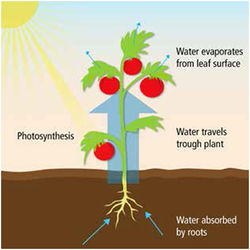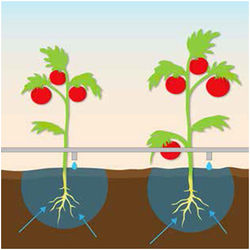SPIS Toolbox - Irrigation Principles

Introduction
The Toolbox on Solar Powered Irrigation Systems (SPIS) is designed to enable advisors, service providers and practitioners in the field of solar irrigation to provide broad hands-on guidance to end-users, policy-makers and financiers. Risks related to system efficiency, financial viability and the unsustainable use of water resources can thus be minimized. The Toolbox comprises informative modules supplemented with user-friendly software tools (calculations sheets, checklists, guidelines). read more
Modules and tools touch upon:
- assessing the water requirements,
- comparing the financial viability,
- determining farm profitability and payback of investment in SPIS,
- sustainably design and maintain a SPIS,
- highlight critical workmanship quality aspects,
- and many more.

style="width: 160px; background-color: rgb(111, 142, 43);" | ►Back to the Module Page
Irrigation Principles
Irrigation is the controlled application of water to respond to crop needs. Water used for irrigation may be taken from nearby lakes, reservoirs, rivers or wells (groundwater), but also from non-conventional sources such as treated wastewater, desalinated or drainage water. Irrigation water is brought to cultivated land by pipes, hoses or ditches.
Producers who irrigate are less dependent on irregular rainfall for their production. Producers can supplement rainfall with irrigation to respond to the amount of water the crop needs. Moreover, control over water improves the efficiency of other yield-improving inputs such as fertilizers and plant protection products. Consequently, the producer’s ability to control the yields is enhanced. This is important for stable productivity and integration into markets.
By irrigating, the soil water storage in the plant root zone is replenished. Instigated by the sun and photosynthesis, plants abstract soil moisture with their roots. This triggers a nutrient flow through the stem to the leaves, from where the water is transpired back to the atmosphere. Thus, only the water that is taken up through the root system contributes to plant and fruit growth.
|
Important: Most of the water that is brought to the field via irrigation should concentrate around the root zone of the plant and the volume of water irrigated should not exceed the plants’ ability to absorb it. |
Water Principles
The amount of water needed by a plant is expressed as Crop Water Requirement (CWR). It depends on the climate, the crop as well as management and environmental conditions. In sunny, hot, dry and windy places the CWR is highest. The crop species, variety and growing phase determine how much water the roots need to take up to enable the plant to grow optimally. Producers can reduce the crop water requirement e.g. through mulching, changing the plant density and applying different irrigation technologies.
The CWR of a particular crop is thus very site-specific and varies day by day. It requires on-site, regional data collection e.g. with support from local extension services, to calculate the CWR (see DESIGN module). CWR is most often expressed in millimeters (mm), or cubic meters per hectare (m3/ha). Normally crops require about 2 to 10 m3 per hectare daily. Details of this assessment are described in the DESIGN module.
It is important to note that water is a priced commodity (water fees, pumping costs) and a scarce resource as other users compete for it (industry, energy, domestic consumption, etc.). This should be considered in financial and ecological feasibility assessments.
Irrigation Efficiency
When irrigating, it is important to apply the right amount of water at the right time. Too little water will lead to wilting and yield reduction. Too much water can lead to water waste, runoff and erosion as well as leaching of nutrients in the soil and salinization, ultimately leading to yield reductions. A 100% efficient irrigation system would provide an equal amount of water to all plants in the field. However, e.g. plants close to the water source tend to get more water than plants at the far end of the field. As a result, yields of the farm are compromised because some plants get too much water and some get too little water. On big farms, this can have serious consequences on operating expenses and management of water resources. The uniformity of distribution of water over the field is determined by the choice of irrigation technology. The three commonly used irrigation methods are:
- surface irrigation;
- sprinkler irrigation;
- drip irrigation.
Surface irrigation methods such as basin, furrow and border irrigation do not achieve more than 60% field application efficiency as only a limited amount of water actually reaches the root zone.
Sprinkler and drip irrigation systems rely on a network of pipes to distribute the water to the field, thereby reducing conveyance losses common for surface irrigation methods. Sprinkler systems achieve an average field application efficiency of 75%, while drip irrigation systems can go up to 95% uniformity. Drip irrigation allows a slow release of water at the plant’s root zone. As a result, soil moisture conditions are good, and no water is “lost” between plants, or on the plants. Crop yields can be doubled, and significant savings can be made in water, energy and labor.





















